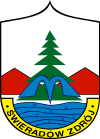Świeradów-Zdrój
| Świeradów-Zdrój | ||
|---|---|---|
|
||
| Coordinates: 50°54′N 15°20′E / 50.900°N 15.333°E | ||
| Country |
|
|
| Voivodeship | Lower Silesian | |
| County | Lubań | |
| Gmina | Świeradów-Zdrój (urban gmina) | |
| Area | ||
| • Total | 20.72 km2 (8.00 sq mi) | |
| Highest elevation | 710 m (2,330 ft) | |
| Lowest elevation | 450 m (1,480 ft) | |
| Population (2006) | ||
| • Total | 4,554 | |
| • Density | 220/km2 (570/sq mi) | |
| Website | http://www.swieradowzdroj.pl | |
Świeradów-Zdrój [ɕfʲɛˈraduf ˈzdrui̯] (German: Bad Flinsberg) is a spa town in Lubań County, Lower Silesian Voivodeship, in south-western Poland near the border with the Czech Republic. The town is located in the Kwisa valley of the Jizera Mountains, a part of the Sudetes range. It lies approximately 25 kilometres (16 mi) south of Lubań, and 123 kilometres (76 mi) west of the regional capital Wrocław.
Świeradów received its town privileges in 1946. As at 2006, it has a population of 4,554.
First mentioned in 1524, the settlement was probably founded at the end of the 13th or the beginning of the 14th century in the Lower Silesian Duchy of Jawor. The oldest record concerning Świeradów, which in fact related to the tavern "Fegebeutel" from which the local settlement of shepherds and lumbermen was named, comes from 1337, while Flinsberg was first documented in 1559. It was located on the eastern slope of the Smrk massif, at the tripoint of historic Silesia with the Bohemian and Upper Lusatian regions.
Exceptional properties of Świeradów mineral springs were suspected as early as the 16th century. In 1572, the Swiss doctor Leonard Thurneysser, private physician of Elector John George of Brandenburg wrote for the first time about the discovery of the exoraordinary features of the local healing waters. They were described by the Protestant reformer Caspar Schwenckfeld about 1600, and Fryderyk Luca also wrote about them in 1683 in his Silesian chronicle. The area was heavily devastated during the Thirty Years' War, at first by Imperial troops under General Ottavio Piccolomini, then by Swedish forces in the course of the seize of nearby Gryf Castle.
...
Wikipedia


